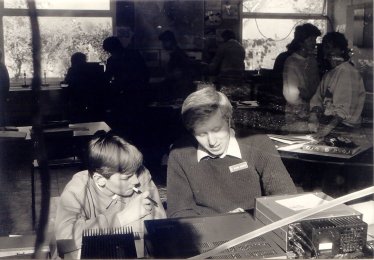

Explaining radio principles
Plenty of "hands-on" experience for students
How it all Began.................
In the early 1980s, Kilve Court Residential Education Centre in Somerset hosted an annual Space Science Week. This provided a rare opportunity for selected pupils from the County's schools to network with specialists and study subjects that were beyond the scope of the National Curriculum.
Part of the week was devoted to the Electro-Magnetic Spectrum and learning about radio communications. Members of the Yeovil Amateur Radio Club were invited to help deliver this session by the County Science Advisor. That's where my involvement began in 1985.
|
|
|
|
|
Explaining radio principles |
Plenty of "hands-on" experience for students |
Having thoroughly enjoyed passing my radio knowledge on to the students, I was invited back the following year to help once again. Over the subsequent decade, staff changes meant that I played an ever-increasing role in the management of the Space Science Week, culminating in my appointment as Director of the Course.
In addition to incorporating plenty of practical work for students, time at home between courses was spent designing new demonstrations and experiments that would help reinforce their learning. Radio astronomy was introduced and we conducted exercises to monitor Solar activity and record the number of meteors entering Earth's atmosphere over a particular night.
|
|
|
|
|
Antennas used to reflect signals from meteor trails |
An early view of the radio "lab" |
|
|
and (later) bounce a radio wave from the Moon's surface |
Note the computer and pen recorder....high-tech at the time |
|
|
||
|
Counting meteors by radio |
||
|
Deflections on the pen recorder indicate a signal, momentarily reflected by the ionised trail of a "shooting star" |
Our most famous "experiment" of that era was when we bounced a VHF radio signal from the surface of the Moon in an attempt to calculate its distance from Earth. Around fifty students stayed-up until 2am and were crammed into the classroom, all armed with stop-watches. The plan was to use a basic "radar" principle and time the delay on the radio signal (travelling at the speed of light) while it made the round-trip to the Moon and back. The students recorded the delays over numerous transmissions using their stop-watches and their findings were averaged to produce a figure accurate to within a few percent of the real value.
Perhaps that wasn't the main success from the event.......one boy on the course was interviewed live by Radio Bristol the following morning. He was so enthused about the course that he decided to study for his Amateur Radio licence. The Radio Society of Great Britain later awarded him the title of "Young Amateur of the Year" and he subsequently chose a career in electronic engineering.
|
Click on the logo above to listen to a Morse Code signal reflected by the Moon's surface |
||
|
(plays a .wav file) |
One feature of the early Space Science Courses was the presentation of the week's work being delivered by students to their parents. Not only did the students enjoy the opportunity to produce a written account of their work on flipcharts and other visual aids (and present the material to the audience), but it provided an excellent means of consolidating their learning. This is a technique I still employ today on current courses.
|
|
||
|
One group of students provide a visual demonstration of |
||
|
how radio signals are relayed by a satellite in Earth orbit |
Since those early days of the Space Science Courses, technology has advanced considerably and modern PCs have revolutionised the tools available to me in the classroom. However, the basics of astronomy, electronics and radio remain the same and I currently offer courses covering all these sciences. The opportunity for pupils to gain practical experience and study topics that enhance their learning under the National Curriculum remains paramount in my course design.
|
|
Two views of Harold, the 12m mobile mast that I now employ on radio-based courses to ensure access to training signals |
|
|
|
||
|
The current "lab" that is used on radio-based courses
|
||
 |
||
| Return to Home Page |